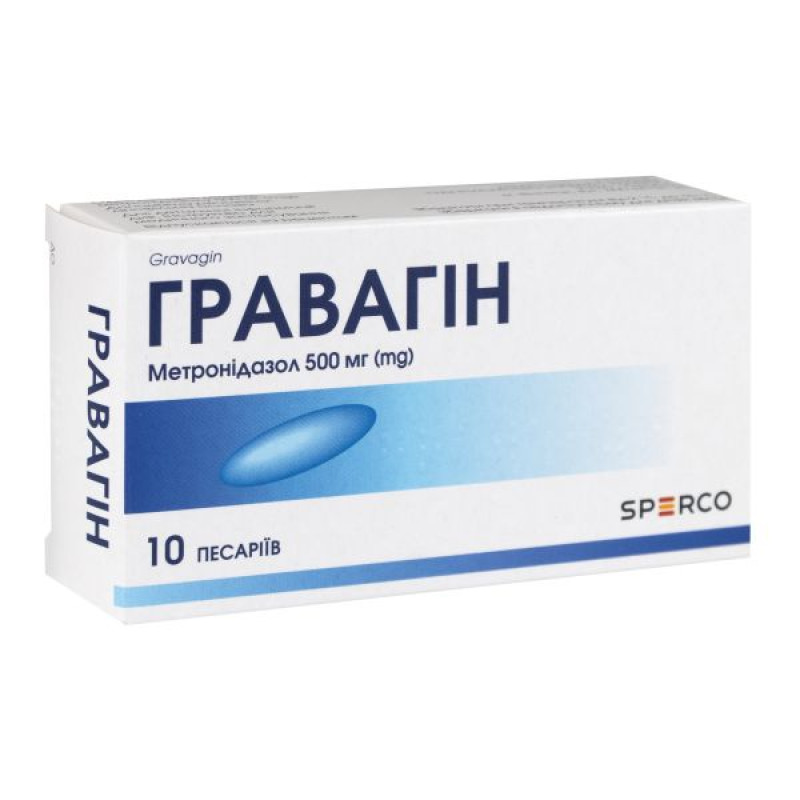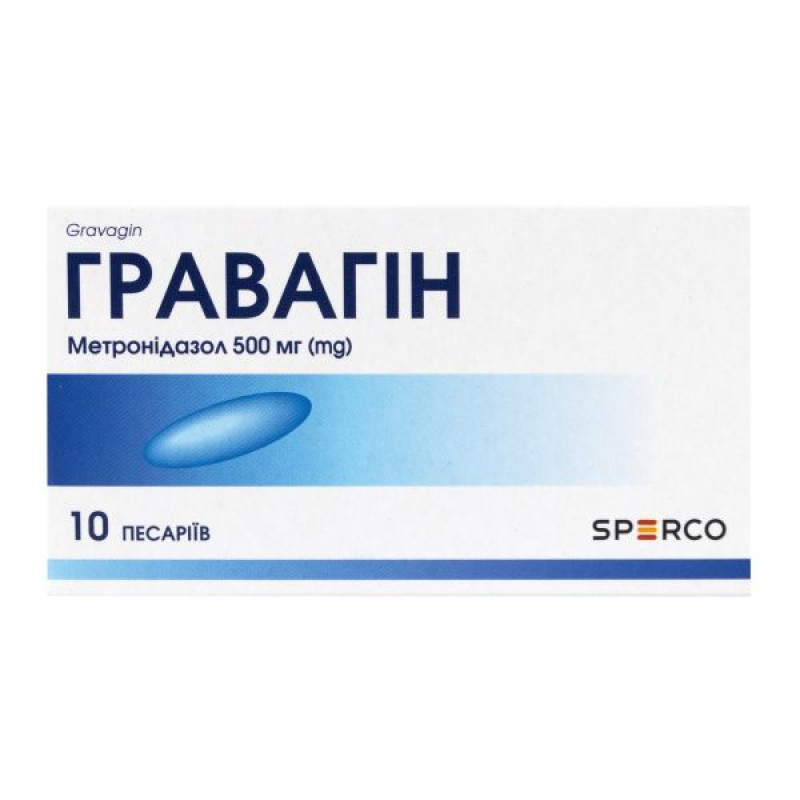Gravagin pessaries 500 mg strip No. 10

Pharmacological properties
Pharmacodynamics. Metronidazole is a derivative of 5-nitroimidazole, has a wide spectrum of antimicrobial activity against gram-positive and gram-negative obligate anaerobic bacteria, as well as protozoa. Sensitive to the drug: peptostreptococcus spp., clostridium spp., bacteroides spp., fusobacterium spp., porphyromonas, bilophila, helicobacter pylori, prevotella spp., veilonella. Metronidazole inhibits the development of protozoa Trichomonas vaginalis, entamoeba histolytica, giardia intestinalis (lamblia intestinalis). Slightly sensitive to the drug: bifidobacterium spp., eubacterium spp. Insensitive to the drug: propionibacterium, actinomyces, mobiluncus. The mechanism of action of metronidazole is associated with a violation of the synthesis of nucleic acids in the DNA of microorganisms, which leads to their death.
Pharmacokinetics. With intravaginal use, systemic absorption of metronidazole is minimal. T ½ of metronidazole, which has entered the systemic bloodstream, is 8-10 hours. 10-20% of metronidazole binds to blood proteins. Penetrates into most organs and body fluids, including breast milk, vaginal secretion, through the placenta in the same concentrations as in blood plasma. Metabolized in the liver, mainly by oxidation with the formation of two active metabolites. Excretion of the drug occurs mainly by the kidneys: 35-65% is excreted in the urine in unchanged form and in the form of metabolites. Metronidazole metabolites color the urine in a red-brown color.
Indication
Local treatment of trichomonas and nonspecific vaginitis.
Application
The drug should be used for the treatment of adult patients only.
Remove the pessary from the contour packaging and insert it deep into the vagina while lying on your back with your knees bent and your legs pulled up to your chest, or in a squatting position.
For the treatment of trichomonas vaginitis, 500 mg (1 pessary) should be administered once daily at night for 10 consecutive days. For trichomonas vaginitis, treatment should be combined with oral metronidazole.
For the treatment of nonspecific vaginitis, prescribe 500 mg (1 pessary) once a day for 7 consecutive days. If necessary, metronidazole for oral use can be prescribed.
Simultaneous treatment of the sexual partner is necessary, even if he or she has no symptoms of infection.
The maximum duration of treatment should not exceed 10 days, and the number of treatment courses should be 2-3 per year.
Contraindication
Hypersensitivity to metronidazole or other components of the drug. Hypersensitivity to imidazole derivatives. It is not recommended to prescribe the drug simultaneously with disulfiram or alcohol.
Side effects
Gastrointestinal: stomach pain, anorexia, nausea, vomiting, diarrhea, taste disturbances (metallic taste in the mouth), stomatitis, glossitis with dry mouth, coated tongue, very rarely pancreatitis, which is reversible.
Skin: flushing, itching, rashes that may be accompanied by fever, isolated cases of pustular rash and erythema multiforme.
Hypersensitivity reactions: hyperemia, urticaria, angioedema, very rarely - cases of anaphylactic shock.
Nervous system: headache, dizziness, ataxia, drowsiness, convulsions, peripheral sensory neuropathy. Very rarely, cases of encephalopathy (confusion, fever, increased sensitivity to light, torticollis, hallucinations, paralysis, visual and movement disorders) and subacute cerebellar syndrome (ataxia, dysarthria, gait disturbance, nystagmus, tremor), which may resolve after discontinuation of the drug, aseptic meningitis, have been reported.
Mental disorders: confusion, hallucinations, depressed mood.
On the part of the organ of vision: diplopia, myopia, blurred vision, decreased visual acuity, changes in color perception, optic neuropathy/neuritis.
On the part of the blood: isolated cases of agranulocytosis, neutropenia and thrombocytopenia, pancytopenia and leukopenia.
Hepatobiliary system: isolated cases of increased liver enzymes (AST, ALT, LF), cholestatic or mixed hepatitis and liver cell damage, sometimes with jaundice. Cases of liver failure have been reported in patients treated with metronidazole and other antibiotics who required liver transplantation.
Musculoskeletal and connective tissue disorders: myalgia, arthralgia.
On the part of the body as a whole: increased body temperature.
During treatment, urine may become red-brown in color.
Special instructions
Metronidazole has no direct effect on aerobic and facultative anaerobic bacteria. Metronidazole should not be prescribed for more than 10 consecutive days and more than 3 times a year.
Patients should be warned that during the period of treatment with the drug, they should completely abandon the use of alcohol, as well as medications containing alcohol.
In the case of combined gonococcal and Trichomonas infection, persistence of gonococci is possible after elimination of Trichomonas.
When performing hemodialysis, metronidazole should be used immediately after the procedure (metronidazole and its metabolites are excreted within 8 hours of hemodialysis).
The dose of metronidazole should not be increased when performing peritoneal dialysis in patients with renal failure.
It is necessary to remember about the risk of deterioration of the neurological condition of patients with severe, chronic or progressive neurological diseases during treatment with metronidazole. In case of long-term treatment, the patient should be monitored for the appearance of neuropathy (paresthesia, ataxia, dizziness, seizures).
If prolonged use of the drug is necessary or if metronidazole is used in high doses, or if it is used in patients with a history of hematological disorders, it is necessary to carefully monitor the hematological picture, especially the number of leukocytes in the blood. For patients with leukopenia, the possibility of continuing therapy should be considered individually depending on the severity of the infectious process.
The drug should be used with caution in patients with hepatic encephalopathy, in which case the daily dose of systemic metronidazole should be reduced by 1/3 (once-daily administration is possible).
When using vaginal suppositories at the same time as condoms or vaginal diaphragms, the risk of latex rupture may increase.
Use during pregnancy and breastfeeding. There is no data on specific teratogenic or fetotoxic effects associated with metronidazole. However, the absence of such a risk can only be confirmed by epidemiological studies. In this regard, metronidazole can be prescribed during pregnancy if the expected benefit to the mother outweighs the possible risk to the fetus. Metronidazole passes into breast milk, so the use of the drug should be avoided during breastfeeding.
Children: The drug should only be used in adult patients.
Ability to influence the reaction speed when driving vehicles or using other mechanisms. If dizziness, hallucinations, seizures or temporary visual impairment are observed during treatment with the drug, you should refrain from driving vehicles or working with mechanisms.
Interactions
Alcohol. You should not drink alcoholic beverages or take medications containing alcohol during treatment and for at least 1 day after its completion due to the possible occurrence of a disulfiram-like reaction (hot flashes, erythema, vomiting, tachycardia).
Disulfiram: Cases of acute transient delusional disorders (acute delirium, confusion) have been reported with concomitant use. This combination is not recommended.
Oral anticoagulants of the vitamin K antagonist group (warfarin, syncumar, phenylin). It is expected that the effect of oral anticoagulants will be enhanced and the risk of hemorrhagic complications will increase due to the slowing of their metabolism in the liver. Frequent and careful monitoring of the international normalized ratio (INR) is necessary. If necessary, correction of the anticoagulant dose is recommended during metronidazole administration and for 8 days after its discontinuation.
Lithium: Plasma lithium concentrations may be increased when used concomitantly with metronidazole. Plasma creatinine, lithium, and other electrolytes should be carefully monitored in patients receiving lithium and metronidazole concomitantly.
Cyclosporine: There is a risk of increased plasma concentrations of cyclosporine with concomitant use. If such a combination is necessary, serum creatinine and cyclosporine levels should be carefully monitored.
Phenytoin and phenobarbital. With simultaneous use, the concentration of metronidazole in the blood may decrease due to accelerated metabolism in the liver.
Fluorouracil. With simultaneous use, a decrease in the clearance of fluorouracil is possible, which leads to an increase in its toxicity.
Busulfan: Concomitant use of these drugs may increase the blood levels of busulfan, which may lead to significant toxicity.
INR changes. There have been numerous reports of increased activity of oral anticoagulants of the vitamin K antagonist group in patients receiving antibacterial therapy. Risk factors for this condition include infection and/or significant inflammation, age, and general health. Certain classes of antibacterial drugs have a greater effect on INR, including: fluoroquinolones, macrolides, cyclines, tetracycline, trimoxazole, and some cephalosporins.
Laboratory results: Metronidazole may immobilize treponema, resulting in a false-positive Nelson test.
Overdose
Leukopenia, neuropathy, ataxia, vomiting, mild disorientation may occur. Specific antidote is unknown. Treatment is symptomatic. Metronidazole is removed from the body during hemodialysis.
Storage conditions
At a temperature of 2-15 °C.
There are no reviews for this product.
There are no reviews for this product, be the first to leave your review.
No questions about this product, be the first and ask your question.












